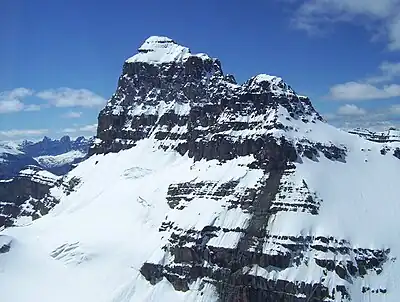Mount Cline
Mount Cline is a mountain in western Alberta, Canada, 11 km (7 mi) north of Saskatchewan Crossing, 60 km (37 mi) southwest of Nordegg.[2]
| Mount Cline | |
|---|---|
 Mount Cline in June 2008 | |
| Highest point | |
| Elevation | 3,361 m (11,027 ft)[1] |
| Prominence | 1,196 m (3,924 ft)[2] |
| Listing | Mountains of Alberta |
| Coordinates | 52°04′12″N 116°40′56″W[3] |
| Geography | |
 Mount Cline Location in Alberta  Mount Cline Mount Cline (Canada) | |
| Location | Alberta, Canada |
| Parent range | Cline Range[4] Canadian Rockies |
| Topo map | NTS 83C2 Cline River[3] |
| Climbing | |
| First ascent | 1927 by J. H. Barnes, A. L. Castle, A. L. Castle Jr., Jimmy Simpson, guided by Rudolph Aemmer[1] |
The mountain is located in the North Saskatchewan River Valley, 2 km (1 mi) west of Resolute Mountain.[1] It was named in 1898 by J. Norman Collie, after Michel Klyne (also called Michael Cline), French Canadian postmaster of Jasper House from 1824 to 1835.[1]
Geology
Mount Cline is composed of sedimentary rock laid down during the Precambrian to Jurassic periods.[5] Formed in shallow seas, this sedimentary rock was pushed east and over the top of younger rock during the Laramide orogeny.[6]
Climate
Based on the Köppen climate classification, Mount Cline is located in a subarctic climate with cold, snowy winters, and mild summers.[7] Temperatures can drop below -20 °C with wind chill factors below -30 °C.
References
- "Mount Cline". cdnrockiesdatabases.ca. Retrieved 2019-08-20.
- "Mount Cline". Bivouac.com. Retrieved 2011-03-29.
- "Mount Cline". Geographical Names Data Base. Natural Resources Canada. Retrieved 2019-09-15.
- "Cline Range". Peakbagger.com. Retrieved 2011-03-29.
- Belyea, Helen R. (1960). The Story of the Mountains in Banff National Park (PDF). parkscanadahistory.com (Report). Ottawa: Geological Survey of Canada. Archived (PDF) from the original on 2015-10-02. Retrieved 2019-09-13.
- Gadd, Ben (2008). Geology of the Rocky Mountains and Columbias.
- Peel, M. C.; Finlayson, B. L. & McMahon, T. A. (2007). "Updated world map of the Köppen−Geiger climate classification". Hydrol. Earth Syst. Sci. 11: 1633–1644. ISSN 1027-5606.
